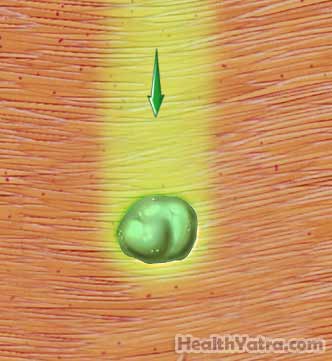Definition
Radiation therapy uses radiation to kill cancer cells and shrink tumors.
Intensity modulated radiation therapy (IMRT) uses radiation beams of different intensities. The beams deliver appropriate doses of radiation to the tumor and reduce the dose to nearby healthy tissue.

Reasons for Procedure
Radiation therapy works to destroy or shrink the tumor to eliminate or prevent the spread of cancer. It can also be used to relieve symptoms caused by the tumor, such as pain and bleeding. Compared with conventional radiation therapy, IMRT can safely deliver greater doses of radiation. The higher dose may also improve the success of the treatment.
Possible Complications
Some normal cells will be damaged with radiation. The goal of radiation therapy is to kill as many cancer cells as possible, while limiting damage to healthy cells.
IMRT is generally associated with fewer side effects than conventional radiation therapy. Side effects vary from person to person, depending on the location of your cancer. Some people experience no side effects at all. General side effects of radiation therapy may include:
- Fatigue
- Skin changes
- Hair loss
- Loss of appetite
- Specific side effects associated with the area of the body being treated
Although uncomfortable, the side effects associated with radiation therapy are usually not serious. They can be controlled with medicine and diet. Your radiation oncologist can explain the side effects you are likely to experience and help determine the best strategies for managing them.
What to Expect
Prior to Procedure
Planning for IMRT is complex and generally takes 2-5 days. Planning may include:
- Physical exam
- Coming in one or more times for imaging tests to identify exactly where the radiation beams will be focused; imaging tests used may include:
- X-ray—a test that uses radiation to take a picture of structures inside the body
- CT scan —a type of x-ray that uses a computer to make pictures of structures inside the body
- MRI scan —a test that uses magnetic waves to make pictures of structures inside the body
- PET scan —a test that uses a special camera to view structures inside the body after a radioactive solution is injected into a vein
- CT/PET scan—a simultaneous fusion of both studies that provides increased accuracy over either study alone
- Marking the locations on the skin where the radiation will be focused to guide the therapist
- Being fitted for a localization device, such as a mask or body frame, to help target accuracy
- Using ultrasound or implanted markers to track the position of the tumor
Description of the Procedure
Using the marks made on your skin as a guide, the radiation therapist will position you on the treatment table. Films or ultrasound may be used to check the accuracy of the treatment setup. The therapist leaves the room to control the movements of the radiation machine. The treatment delivers radiation in a three-dimensional manner. This will help to conform as closely as possible to the shape of the tumor. The healthy tissue receives smaller doses of radiation than the tumor.
You will be asked to remain still during the radiation treatment. You may breathe normally. In general, you will not feel or sense anything during treatment. However, the machine can be stopped if you feel sick or uncomfortable. The therapists will be observing you with a monitor. You will be able to communicate to them should you need to.
Immediately After Procedure
You will be able to leave and resume your normal daily activities. Receiving IMRT does not make you radioactive. You do not need to avoid being around other people because of the treatment.
How Long Will It Take?
Each session will take 15-30 minutes. Patients are typically scheduled for IMRT five days per week for 4-8 weeks.
How Much Will It Hurt?
Holding one position may become a little uncomfortable, but it is not painful.
Post-procedure Care
During treatment, your doctor will want to see you at least once a week. You may have blood tests or other studies performed.
After your treatment is completed, you will come in for regular visits to monitor for side effects and healing and check for signs of recurrent disease. You may require further testing, medicine, or rehabilitative treatment. Be sure to follow your doctor’s instructions .
Call Your Doctor
After arriving home, contact your doctor if any of the following occurs:
- Persistent pain
- New or unusual lumps, bumps, or swelling
- Nausea, diarrhea, vomiting, or loss of appetite
- Unexplained weight loss
- A cough, sore throat, or fever that does not go away
- Unusual changes to skin, including rashes, bleeding, or bruising
- Other symptoms you are concerned about
In case of an emergency, call for medical help right away.
